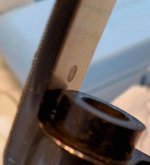I bought a 27-9 last Summer, and after reading a few reports of finish damage, believed to be caused by the sight leaf screw not completely filling the hole in the top strap- the theory being that the edge of the hole was redirecting expanding gasses downward to the cylinder between the flutes -I asked S&W, while my gun was in for warranty service (repair frame, repair yoke, repair hammer, on a new, unfired gun . . .), to replace the screw with a longer one.
They didn't replace the screw, and made no comment. After sitting on the gun for a few months, I read another internet reference to a longer screw being available, contacted customer service, and they mailed two .010"-longer screws.
The screw swap was easy, I spent a lot more time padding the vice and and wrapping the gun than in swapping the screws, and the new one is a much better fit.
They didn't replace the screw, and made no comment. After sitting on the gun for a few months, I read another internet reference to a longer screw being available, contacted customer service, and they mailed two .010"-longer screws.
The screw swap was easy, I spent a lot more time padding the vice and and wrapping the gun than in swapping the screws, and the new one is a much better fit.




